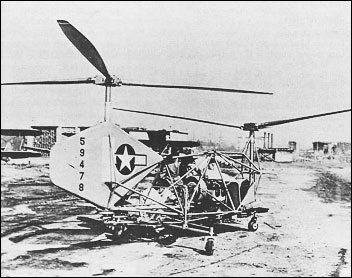|
The Rotor-Craft XR-11, designed by Mr. Gilbert Magill, is so far the only tandem rotor helicopter to have flown with rigid blades, and it is claimed that inherent stability has been built into the design without resorting to the use of auxiliary aerofoils or gyroscopic weights. It has been under development for the U.S.A.F. for some three years and is at present being tested at the Cal-Aero Technical Institute at Glendale, California.
The most interesting feature of the XR-11 is the rigid mounting of the rotor blades, without hinges or flapping joints, the rotor discs constantly remaining perpendicular to the shafts and following broadly the principle of the controllable-pitch airscrew. Pitch control rods are enclosed in hollow drive shafts, resulting in a very clean assembly. The blade roots embody levers, which enter the hollow drive shafts via slots, connecting with their respective pitch control rods; the two three-bladed oppositely rotating rotors are mounted in tandem and overlap, the forward rotar turning anti-clockwise and the aft rotor turning clockwise. It is of interest to note that e.g. location is some 40% to the rear of the forward rotor shaft, which is therefore carrying some 50% greater disc loading than the rear shaft.
Swashplates for cyclic and collective pitch changes are positioned at the bases of the rotor drive shafts, eliminating a number of components normally used for transferring control movements. Mr. Magill claims that the control system is extremely sensitive and the lag in control response is almost imperceptible. A number of standard automotive parts are incorporated in the structure, reducing initial costs and maintenance time. The clutch and gears in the rotor assembly are reworked Ford units, a Studebaker free-wheeling unit is employed and all the universal joints are standard car accessories.
Welded steel-tube construction is used for the fuselage and the rotor blades are of laminated birch construction. The engine is a 110hp Continental C-100 flat four; gross weight is 615kg; Production largely depends upon whether an Air Force contract is forthcoming, but the Company hope to enter the commercial field with a 2-seater, and estimate that the initial price in the case of a series of 500 machines would be GBP2,500 each, followed by a sliding scale to GBP1,250. "Flight", January 27th, 1949
In 1945 the Rotor-Craft Corporation began developmental work on a helicopter with tandem rotor configuration, designed by its President, Gilbert W. Magill, and embodying various novel features, especially the use of a rigid rotor system. The only designer in the United States to have preceded Magill in this line was Landgraf, who employed side-by-side rotor blades fixed rigidly to the hubs.
In 1953 Rotor-Craft acquired the patents of the Landgraf Helicopter Company, including those related to 'rigid rotors'. At the time Magill stated: 'Rigid rotor helicopters will be less costly to produce, and the safety of rigid blades that cannot droop and endanger passengers or others approaching the machine is expected to be attractive to both armed services and commercial helicopter operators.'
The absence of reliable technical data about its own particular version of the rigid rotor concept decided Rotor-Craft to design a test stand which would enable a quarter-scale rotor assembly to be thoroughly tested during the developmental stage.
X-2 DRAGONFLY
This helicopter had two three-bladed rotors set in tandem and overlapping though separated by a distance of 3.76m; the level of the rear rotor was above that of the forward rotor.
The blades, rigidly attached to the hub, were connected in such a way that their span axis was at the rear of the driving shaft.
For forward or backward flight the swash-plate was tilted fore and aft by a push-pull rod, while collective pitch change was obtained by raising or lowering another push-pull rod. The swash-plate was mounted, not beneath the rotor hub, but at the base of the driving shaft.
The aircraft's centre of gravity was closer to the front than to the rear rotor, which thus resulted in heavier disc loading upon the forward than upon the rear rotor.
Consideration was given to developing an extrapolation of the Dragonfly to be known as the Rotorbus, a helicopter capable of carrying twenty passengers. P.Lambermont "Helicopters and Autogyros of the World", 1958
* * *
One Rotorcraft XR-11 was built for evaluation by the USAAF. The helicopter had contra-rotating, intermeshing rotor blades with the hubs of the three-bladed rotors 3.76m apart. It had a welded steel tubular construction with fabric covering.
Soon the designation of the helicopter was changed to XH-11 but the project was cancelled. www.secretprojects.co.uk
* * *
| Technical data for X-2 Dragonfly
Engine: Continental A 100, 100hp,
rotor diameter: 5.49m,
overall length: 4.57m,
height: 2.29m,
weight empty: 408kg,
weight fully loaded: 612kg
|
Warning: mysqli_connect(): php_network_getaddresses: getaddrinfo for mysql5.zone.ee failed: Name or service not known in /data03/virt15346/domeenid/www.aviastar.org/htdocs/helicopters_eng/rotorcraft_dragonfly.php on line 111
Fatal error: Uncaught mysqli_sql_exception: php_network_getaddresses: getaddrinfo for mysql5.zone.ee failed: Name or service not known in /data03/virt15346/domeenid/www.aviastar.org/htdocs/helicopters_eng/rotorcraft_dragonfly.php:111
Stack trace:
#0 /data03/virt15346/domeenid/www.aviastar.org/htdocs/helicopters_eng/rotorcraft_dragonfly.php(111): mysqli_connect('mysql5.zone.ee', 'd14657sa18989', Object(SensitiveParameterValue))
#1 {main}
thrown in /data03/virt15346/domeenid/www.aviastar.org/htdocs/helicopters_eng/rotorcraft_dragonfly.php on line 111
| 




